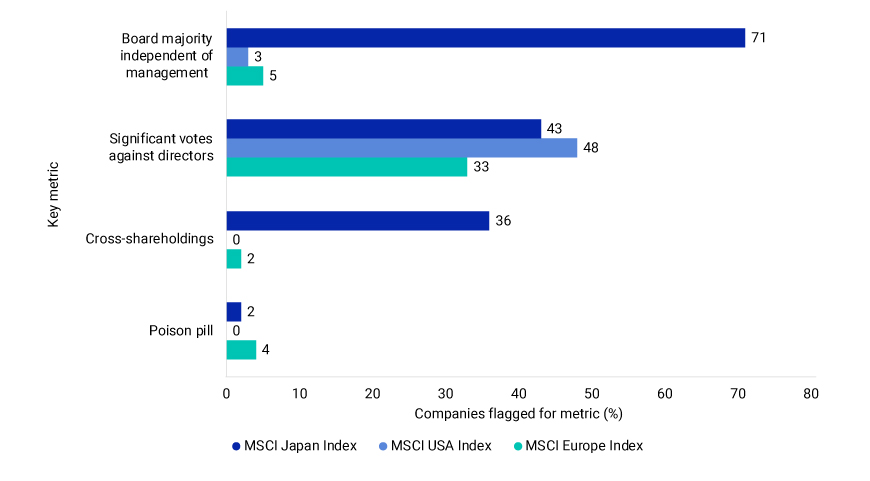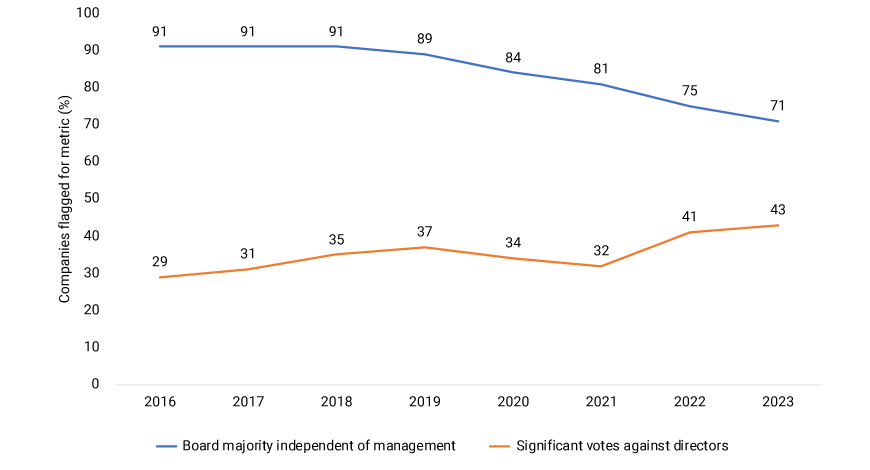The Japanese equity market’s resurgence in performance that began over two years ago has been ascribed to investors’ reallocating assets out of China, the seeming end of nearly two decades of deflation, regulatory reforms and a long-sought corporate refocus on shareholder value.[1]
In this blog post we assess the degree to which regulatory reforms have changed corporate fundamentals and governance. Our conclusion is that although governance practices have made progress, improvements in fundamentals have lagged, which may become a concern as investors assess their portfolios’ allocations to this market.
Capital efficiency and margins still disappoint
Capital efficiency and return on equity (ROE) have become major talking points between investors and companies.[2] Scrutiny is likely to increase with the Tokyo Stock Exchange (TSE) now maintaining a monthly list of companies that voluntarily disclose information regarding “actions to implement management that is conscious of cost of capital and stock price.”[3] The TSE initiative was designed to shine a light on the half of TSE-listed companies with a price-to-book (P/B) ratio below one (i.e., market value below book value). These low P/Bs indicate that asset values were still being discounted to reflect low estimates of future earnings or that many Japanese companies were eroding value in their use of shareholder capital.
The ROE of Japanese mid- and large-cap companies has remained lower than those of their U.S. and European peers for more than 30 years. In part, the lower ROE reflects Japanese companies’ lower leverage based on a DuPont-style ROE decomposition, which breaks down the metric into net profit margin, asset turnover and leverage. Lower debt has resulted in higher asset turnover, however, partially offsetting this effect. Lower net profit margins have also depressed ROE.[4] In general, lower margins have stemmed from weaker gross profitability. An improvement in gross profit margins would require changes in cost structures, supplier strategy and pricing.
Selected fundamental metrics for Japanese, US and European equity markets

Governance push aims to improve financial performance
The proportion of Japanese companies with a P/B below one may indicate that Japan’s management culture has historically placed insufficient priority on shareholder value.[5] One aim of Japan’s adoption and subsequent revisions of its Stewardship Code and Corporate Governance Code has been to encourage alignment between shareholder and corporate interests and to promote board accountability.[6] Investor and regulatory pressures have focused on increasing board independence to improve management oversight and discourage practices that may insulate management from pressure to unlock shareholder value.
Cross-shareholdings[7] — rare in other developed markets — have historically been maintained by Japanese companies to support business relations. The practice has been criticized as an inefficient use of capital, with longstanding calls to unwind such relations.[8] The percentage of constituents in the MSCI Japan Index flagged for cross-shareholdings in 2023 dropped to 36%, down from 43% in 2019. Simultaneously, poison pills — often criticized by investors as limiting opportunities for shareholders to consider potentially favorable takeover bids — have notably declined. The percentage of the MSCI Japan Index’s constituents flagged for a poison pill in 2023 dropped to 1.8%, down from 5.6% in 2019.
Percent of Japanese, US and European companies flagged for selected governance key metrics

Shareholder voting behavior shifted markedly following the adoption of the Stewardship Code in 2014. Since 2016, the share of boards flagged for having less than a majority of directors who are independent of management — often regarded as best practice by investors — has decreased at a rate roughly consistent with the increase in boards flagged for significant votes against directors. The changes in these metrics suggest investors may be more willing to hold boards accountable for perceived governance and performance failings.
Board accountability and independence at Japanese companies

Improving capital efficiency may be key to continued strong equity performance
Outperforming global equity markets over the last two years, the Japanese stock market’s rally continued through February 2024. Gross local-currency returns for the MSCI Japan and MSCI ACWI ex Japan Indexes were -4 % and -16% in 2022, and 29% and 22% in 2023, respectively. In USD terms, the gross returns of the two indexes were -16% and -18% in 2022, and 21% and 23% in 2023, respectively. The performance of Japanese stocks can be largely attributed to sales growth.[9] Earnings growth, however, has not followed in step, and margins have deteriorated.
Decomposition of Japanese, US and European equity-market returns

The gradual improvements in Japanese firms’ governance practices have occurred in response to both investor and regulatory pressures. The question now is whether external pressure can similarly enhance capital efficiency. Attaining greater capital efficiency may be the key to unlocking shareholder value and continued strength in the Japanese equity market.

